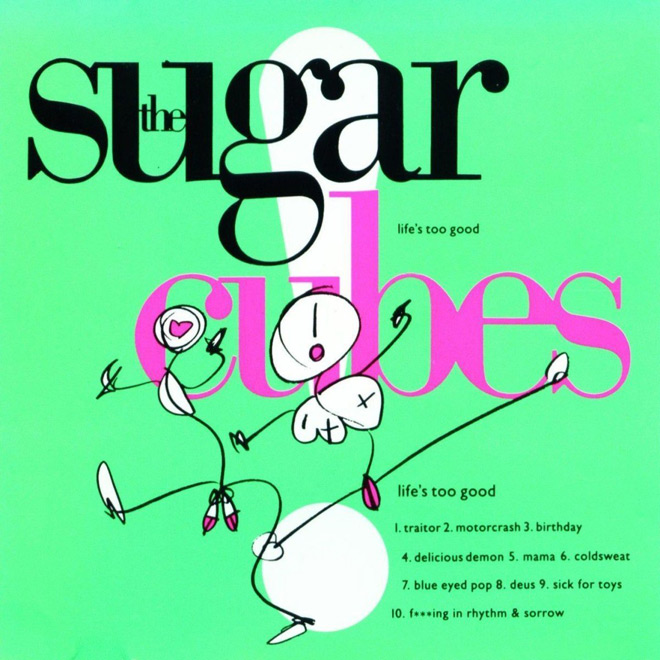Björk is now a world-renowned Worldbeat-inspired Pop singer-songwriter, whose body of works are prized for its boundary-pushing and genre-encompassing distinction. In fact, she has just released her ninth solo album last year. However, long before the diminutive but larger-than-life Icelandic artist became prominent in the international music scene, she was a member of that little, quirky band called The Sugarcubes.
Formed in 1986, in Reykjavík, Iceland, The Sugarcubes’ claim to popularity in their home-country and credit for being a part of the entire Post-Punk New Wave/Alternative Rock genre may be encapsulated in their three-album studio discography: 1988’s Life’s Too Good; the ensuing year’s follow-up, Here Today, Tomorrow Next Week!; and the final opus, 1992’s Stick Around for Joy. Because the debut is celebrating its 30th anniversary this month, to know more about Björk’s musical roots via The Sugarcubes is essential in further understanding the eccentricity and idiosyncrasies of the often-misunderstood and fiery artist.
Released in April 1988, on One Little Indian and Elektra Records, The Sugarcubes’ first album was the effort of Björk Guðmundsdóttir (vocals, keyboard) and her mates in the band at the time: Bragi Ólafsson (bass), Sigtryggur Baldursson (drums), Þór Eldon (guitar), and Einar Örn Benediktsson (vocals, trumpet). It opened with the Shoegaze-flavored, sugary-Pop “Traitor,” which immediately established the playful male-female vocal banter between the two vocalists, Björk and Einar Örn. This interplay subsequently became a trademark of The Sugarcubes’ music. Followed next was the album’s shiniest track – the upbeat and melodic “Motorcrash,” which further highlighted Björk’s very powerful voice and Einar Örn’s vocal antics and decidedly Icelandic accent. However, the mighty vocal prowess of Björk, which could turn whimsically from a twee coo of a pixie to an ominous growl of an orc, soared its highest flight in the choppy and subtly jazzy “Birthday,” the band’s first international single. The Sugarcubes’ storytelling continued with the stomper “Delicious Demon.”
The mood then turned slow and a bit Gothic with “Mama,” whose scathing guitars might have reminded the initiated of Siouxsie & the Banshees’ “Slowdive.” Another rockin’ and sinister-sounding track followed in the form of “Coldsweat,” conjuring an image of a very self-assured young band. “Blue-Eyed Pop” was certainly a proper Post-Punk song; its slicing and angular guitars and cascading basslines placed itself in the league of the pioneers of the genre, such as Gang of Four (“Damaged Goods”), Joy Division (“Isolation”), and Bauhaus (“Double Dare”).
“Deus” was a return to saccharine and sunny bliss, sparkling with its graceful keyboard flourishes, bouncy bass lines, guitar reverbs, dancy drumbeats, and Björk’s relatively mild and tuneful vocal attack. Another The Banshees deadringer, “Sick for Toys” reverted the overall ambience to frenetic mode. Finally, The Sugarcubes finished up Life’s Too Good in a quite wacky and frolicsome manner, with the rather countryside and carnivalesque, double-time rhythm of “Fucking in Rhythm and Sorrow.”
Many music listeners hail and adore artists whose music they say they hold close to their hearts. However, more often than not, they turn out to be familiar with only the breakthrough album or mainstream hits of these artists. That goes the same about Björk. Many people say they love her music, but fail to know her roots. So, this is a chance!
Celebrate Björk’s musical past by revisiting the music of her former band The Sugarcubes, starting with Life’s Too Good. Then, after you have finished giving all three Sugarcubes albums their individual spins, backtrack some more, to discover that Björk had actually started her singing career when she was 11 years old, releasing her first-ever, self-titled album in 1977; but that is for another time and circumstance. For the meantime, suck on some 30-year-old Icelandic sonic sugar cubes and satisfy your good ol’ sweet tooth.






No comment